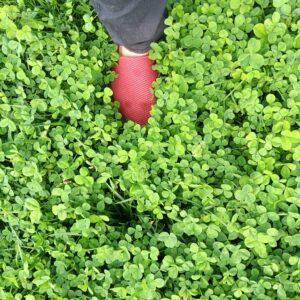Revised August 4, 2024
Sometimes there are certain areas of the lawn that constantly cry for maintenance. Traditional bluegrass lawns demand food, water, temperate weather and are disease prone. Even fescue has some limits.
One local resident has researched alternatives and starting in the drought of 2023, is experimenting with perennial white mini-clover in a contained area. The site chosen is full sun and confined on three sides by hardcover. Turf grass in this space needed constant watering, and the area was hard to mow making it a viable candidate for experimentation.
The homeowner wants to keep a larger area of fescue turf so this small, contained space keeps the clover from spreading. After some research, small-leafed, drought and wear-tolerant mini clover seemed worth a logical try.
Below is the “layperson’s experience report.”
- Outside Pride White MiniClover was chosen.
- Germination occurred within 74 hours, even in the heavy black clay-like soil of the South Lake Minnetonka area!
- Within four weeks the clover was a deep, lush groundcover-with no watering.
- Mowing is optional but not necessary, though recommended at season-end.
- When taller, the clover “tramples down” from walking, but does recover in a few hours.
- In season two, this perennial came back more lush, growing to about 10”, with some white blooms that attract a variety of bees.
- The clover draws nitrogen into the ground stimulating health in the underlying grass.
- Density of the clover smothers out any weeds.
- If mowing is chosen, it should be with regular frequency before the clover gets too tall.
- Having a green “salad” in your front yard can be an amazing conversation piece.
More reading:
Was this post useful?
Average rating 5 / 5. Vote count: 3
No votes so far! Be the first to rate this post.













